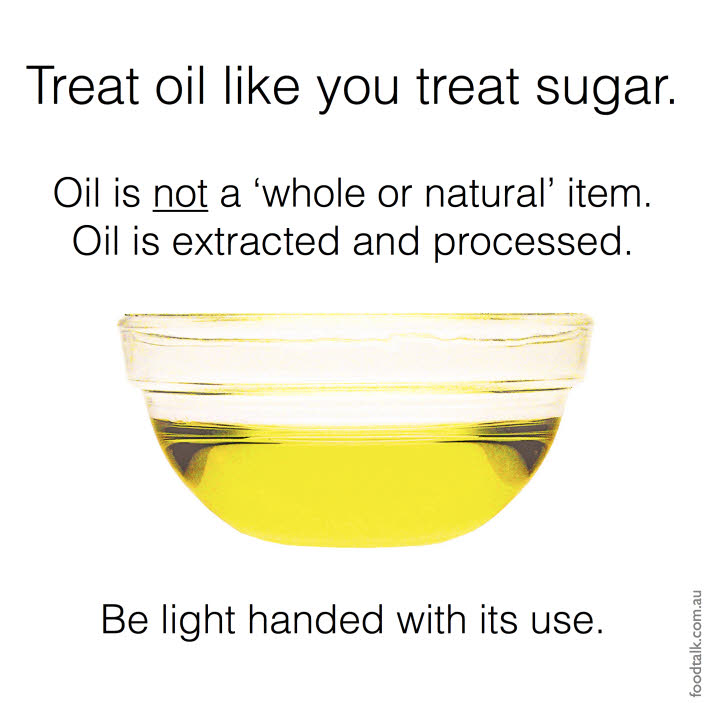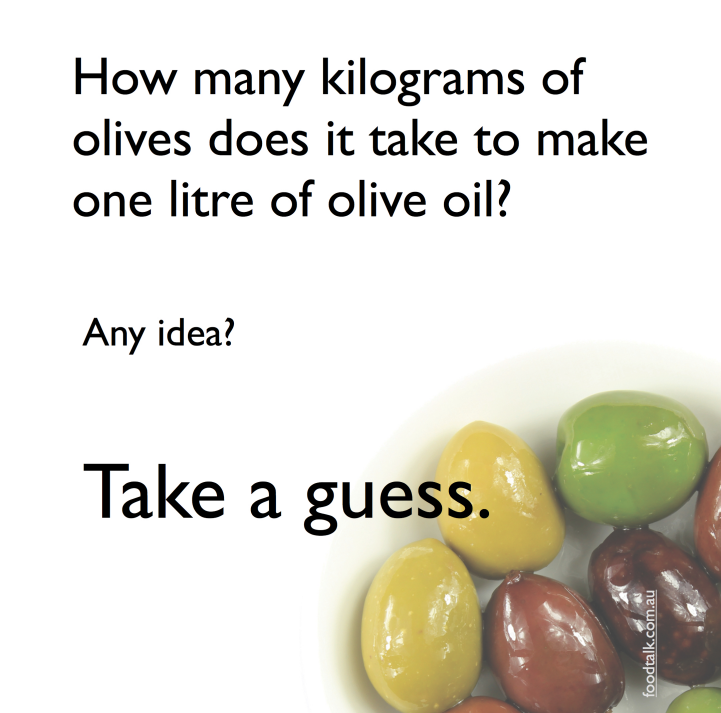Oil is a processed food ingredient.
Is it time to clear bottled oils from your fridge and pantry?

Have you ever tried to extract oil from olives? How about from nuts or avocado?
It is not an easy process and you don’t get a lot of oil for the effort.
Sure when you crush a nut on a napkin, you’ll see a shiny oil smear but as far as pressing enough oil out to make salad dressing?
Edible oils are a processed food ingredient. The majority of edible oils are highly refined, filtered and extracted. Edible oils do not exist as a ‘whole or natural’ item.
Massive amounts of pulp remain behind in factory vats after oil extraction. The pulp contains significant nutrients that are removed from our diet when we choose to use an oil instead of eat the whole food from which it was extracted.
Cane sugar and oil are similar in that both are extracted from plant sources. The same could be said of filtered fruit juice. Much of the nutritional goodness from the original whole plants is lost to human consumption in the extraction process. So it begs the question "why are bottled oils still recommended yet sugar is not and fruit juice is discouraged?" And "why is extra virgin olive oil being pushed so heavily?".
Oil manufacturers, their global organisations and their avid spokespeople skirt around food law to make off-label claims about the beneficial aspects of oils on health: the types of fat present, the anti-oxidant potential and content as polyphenols, vitamin E content, and effect on general health (reduce inflammation, reduce cholesterol levels, body weight).
Research is often sponsored by oil industry groups. Industry sponsored and vetted research concerns me. The scientific journals are also cherry-picked for articles that support the argument for you and I to use more and more oil. Vocal in this arena are the advocates for extra virgin olive oil and coconut oil. It is as though some oils including extra virgin olive oil and coconut oil have taken up medicinal status without undergoing rigorous independent trials on the background of everyday typical Australian diets.
The Mediterranean extra virgin olive oil (EVOO) advocates propose that adults ought to consume ¼ to ⅓ cup (60 to 80 ml) EVOO plus eat almost ¼ cup (30 g) nuts and seeds each day. This simple message gives permission to keep fried food, oil laden recipes and oil smothered foods on the menu.
But you need to know this high medicinal dose of oil was used as part of strict energy-controlled Mediterranean dietary trials where participants cut out all other fat sources in their diet (no other oils, no butter, no cream, no ghee, no manufactured foods containing fats and oils), reduced their total animal food intake (less meat and dairy), increased their intake of whole plants (legumes, lentils, vegetables, wholegrains, fruit), and ate no junk.
Unless you make similar total dietary changes the high daily dose of oil with nuts will lead to massive weight gain. If you do nothing else except simply add more oil and nuts to your usual cooking and recipes at home, you will gain weight. If you are already gaining weight and simply swap to EVOO from your current oil, the weight will continue to climb. No ifs, no buts.
If you do make all the other dietary changes, your body will be much healthier with or without the addition of extra oil.
The social media marketing hype gurus also forget to mention the nutrients present in oils came from the original food source so why not simply consume the whole food to get the oily nutrients plus a whole lot more?
Work out how much liquid oil you use a week. Use the table below to work out how much whole food was needed to produce that oil.
Imagine if for one week you dropped all oil from your diet and replaced it with an equal amount of whole food. Would you be able to physically eat the amount of food rather than use the oil? I am not suggesting you try!
Before you scan the table below, answer the question …

| Source food for oil | To make 1 L of oil, it takes this amount of source food* | 1 tablespoon (tbs) of pure oil is extracted from this amount of source food* |
| Olives, seeds and flesh | 4.79 kg | humans don’t eat the seeds but 1 tbs needs 96 g entire olives |
| Olives, flesh only | 5.1 kg | 102 g (about 22 table olives) |
| Avocado | 3.62 kg | 72 g (about 3 slices or ¼ cup mashed) |
| Macadamia | 1.19 kg | 23 g (about 9 macadamia) |
| Sunflower | 1.8 kg | 36 g (almost 3 tbs seeds) |
| Sesame | 1.65 kg | 33 g (about 2½ tbs seeds) |
| Peanut | 1.93 kg | 38 g (3 tbs or about 18 unshelled nuts) |
| Canola | 2.09 kg | humans don’t eat canola seeds |
| Rice bran | 20 kg | 400 g (unrealistic amount for anyone to eat) |
| Coconut | 3.05 kg | 61 g (about ⅓ of a coconut) |
| Pumpkin seed | 1.98 kg | 39 g (about 3 tbs seeds) |
| Wheat germ | 13.1 kg | 26 g (about ⅓ cup) |
| Walnut | 1.32 kg | 26 g (about ⅓ cup or 7 walnut halves) |
* Extraction rates vary widely between manufacturing processes. It is never 100% extraction. There are also seasonal and varietal differences in the actual oil content of the source food used. Therefore the amount shown likely underestimates how much of the source food is needed to produce 1L of oil.
To eat an equivalent amount of source food is an interesting imaginary challenge. If you are not heavy handed with oil, the swap to add whole nuts, seeds, avocado and olives to recipes, snacks and meals might be fairly straight-forward. But heavy-handed oil users may struggle. This struggle is a signal to pull back on how much and how often they use oil, and to reduce how often they eat out.
If you have concerns about excess weight gain or are struggling to lose weight, take notice of how long a bottle of oil lasts in your house. You may be too heavy handed at home or you may be eating too much oil-laden fat-rich food made away from home (from restaurants and eateries, fast or slow, gourmet or convenient).
Do I use oil? Yes, in small amounts for everyday meals.
- I don’t use non-stick pans and prefer to use a smear of oil in stainless cooking pans if needed.
- At my home are several types of oil. I prefer variety because each oil supplies a subtly different fatty acid profile (polyunsaturates and monounsaturates) and oils perform and taste differently in cooking and in dressings. I do not use canola, blended vegetable and coconut oils.
You don’t need to cut out oil. Here’s a good rule of thumb for how much oil to use.
- For most basic recipes such as stir fries, roasted vegetables and dressed salads, allow about one teaspoon of oil per person to be served. Some meals need no oil (in slow cooker and on BBQ) but other recipes need more (shallow or deep fry).
Have you ever wondered what happens to the pulp left after oil extraction?
The pulp left behind from avocado, coconut, soybean, corn, seeds, peanuts and other nuts after oil extraction is useful in feed for livestock. Other applications include compost from avocado pulp and peanut meal, flours for human consumption from some nut meals, and wheatgerm meal as an additive in baking and cereal manufacture.
Olive waste is different. I am not an expert on the use of olive waste and by-products but this expert report Recycling Solid Waste from the Olive Oil Extraction Process Rural Industries Research and Development Corporations Aus Gov. Pub No 08/165 indicates that "olive mill waste is a continuing environmental concern in Australia and the rest of the world. A comprehensive low impact way of dealing with mill waste is lacking. The high phenol content of husk and wastewater from some production methods is toxic to humans, animals and plants. Selective composting and bio-fuel production are two theoretical options but full application of these is lacking".
Are you adding to the environmental impact by using too much oil, any kind of oil?
